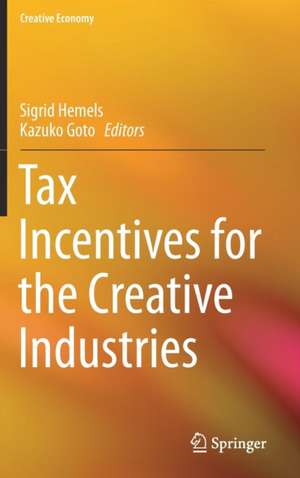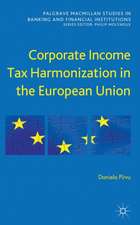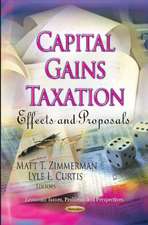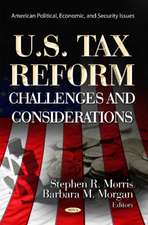Tax Incentives for the Creative Industries: Creative Economy
Editat de Sigrid Hemels, Kazuko Gotoen Limba Engleză Hardback – 12 ian 2017
| Toate formatele și edițiile | Preț | Express |
|---|---|---|
| Paperback (1) | 779.39 lei 6-8 săpt. | |
| Springer Nature Singapore – 11 dec 2018 | 779.39 lei 6-8 săpt. | |
| Hardback (1) | 785.42 lei 6-8 săpt. | |
| Springer Nature Singapore – 12 ian 2017 | 785.42 lei 6-8 săpt. |
Preț: 785.42 lei
Preț vechi: 957.83 lei
-18% Nou
Puncte Express: 1178
Preț estimativ în valută:
150.31€ • 156.35$ • 124.09£
150.31€ • 156.35$ • 124.09£
Carte tipărită la comandă
Livrare economică 15-29 aprilie
Preluare comenzi: 021 569.72.76
Specificații
ISBN-13: 9789812878311
ISBN-10: 9812878319
Pagini: 260
Ilustrații: XIII, 245 p. 4 illus., 2 illus. in color.
Dimensiuni: 155 x 235 x 16 mm
Greutate: 0.54 kg
Ediția:1st ed. 2017
Editura: Springer Nature Singapore
Colecția Springer
Seria Creative Economy
Locul publicării:Singapore, Singapore
ISBN-10: 9812878319
Pagini: 260
Ilustrații: XIII, 245 p. 4 illus., 2 illus. in color.
Dimensiuni: 155 x 235 x 16 mm
Greutate: 0.54 kg
Ediția:1st ed. 2017
Editura: Springer Nature Singapore
Colecția Springer
Seria Creative Economy
Locul publicării:Singapore, Singapore
Public țintă
ResearchCuprins
1 Introduction (Sigrid Hemels).- Part I Theoretical Context of Tax Incentives for the Creative Industries.- 2 Defining Creative Industries (Kazuko Goto).- 3 Why Do Governments Financially Support the Creative Industries? (Kazuko Goto).- 4 Tax Incentives as a Creative Industries Policy Instrument (Sigrid Hemels).- 5 Tax Incentives, Harmful Tax Competition and State Aid Considerations in the EU (Raymond Luja).- 6 Tax Incentives Crossing Borders. Considering the Example of Tax Incentives for Charitable Giving (Renate Buijze).- Part II Cases: focus on specific tax incentives.- 7 Tax Incentives for Museums and Cultural Heritage (Sigrid Hemels).- 8 Tax Incentives for the Audio Visual Industry (Sigrid Hemels).- 9 Tax Incentives for the Art Market (Sigrid Hemels).- 10 Tax Incentives for Copyright (Dick Molenaar).- 11 Tax Incentives for Artists (Dick Molenaar).- Part III Conclusion.- 12 Conclusion (Sigrid Hemels).- Index.
Recenzii
“The chapters are written by legal and by economics scholars and are admirably international in scope, providing interesting comparisons of tax incentives, and extensive references for those who want to know more about individual policies in specific countries. … I finished the book glad to have learned so much about tax incentive policies around the world … .” (Michael Rushton, Journal of Cultural Economics, Vol. 41, 2017)
“… As soon as you open the book, you immediately notice the thorough structure. ... Thanks to this clear structure this book is also suitable as a reference book. … As I stated in my introduction, the authors set the bar high. A book that pretends to have added value for academics, students, politicians, policy makers and other interested readers must be very special. And that is the case.” ((Translated from Dutch, Leen Wisker, Boekman (111), 2017)
“… As soon as you open the book, you immediately notice the thorough structure. ... Thanks to this clear structure this book is also suitable as a reference book. … As I stated in my introduction, the authors set the bar high. A book that pretends to have added value for academics, students, politicians, policy makers and other interested readers must be very special. And that is the case.” ((Translated from Dutch, Leen Wisker, Boekman (111), 2017)
Notă biografică
Editors
Sigrid Hemels received her Ph.D. in tax incentives for the arts from Leiden University in the Netherlands in 2005. She is full professor of tax law, Erasmus School of Law (ESL), Erasmus University Rotterdam; programme leader of the ESL Research Programme Fiscal Autonomy and Its Boundaries; and head of the ESL Department of Tax Law. She is also senior professional support lawyer at the Amsterdam office of Allen & Overy LLP and a member of the supervisory boards of several Dutch cultural institutions. Dr. Hemels frequently publishes and lectures, both in the Netherlands and abroad, on various tax topics, including tax incentives for charities, art, and cultural heritage.
Kazuko Goto received her Ph.D. in economics from Kyoto University in 1998. She was professor at Saitama University, 2004–2014, and visiting professor at Erasmus University Rotterdam, 2004–2005. At present, she is a professor at Setsunan University in Osaka, where she has been since 2014. She was an executive board member of the Association for Cultural Economics International, 2006–2012. Prof. Goto also was editor in chief of Bunka Keizaigaku (Cultural Economics), 2006–2010, and was president of the Japan Association for Cultural Economics, 2010–2012. She has been an executive board member of the Japan Institute of Public Finance since 2016. Currently, she researches on creative industries from the point of view of tax incentives, copyright, and regional development. She also serves as a member of various committees in national and local governments and contributes to policy making.
Sigrid Hemels received her Ph.D. in tax incentives for the arts from Leiden University in the Netherlands in 2005. She is full professor of tax law, Erasmus School of Law (ESL), Erasmus University Rotterdam; programme leader of the ESL Research Programme Fiscal Autonomy and Its Boundaries; and head of the ESL Department of Tax Law. She is also senior professional support lawyer at the Amsterdam office of Allen & Overy LLP and a member of the supervisory boards of several Dutch cultural institutions. Dr. Hemels frequently publishes and lectures, both in the Netherlands and abroad, on various tax topics, including tax incentives for charities, art, and cultural heritage.
Kazuko Goto received her Ph.D. in economics from Kyoto University in 1998. She was professor at Saitama University, 2004–2014, and visiting professor at Erasmus University Rotterdam, 2004–2005. At present, she is a professor at Setsunan University in Osaka, where she has been since 2014. She was an executive board member of the Association for Cultural Economics International, 2006–2012. Prof. Goto also was editor in chief of Bunka Keizaigaku (Cultural Economics), 2006–2010, and was president of the Japan Association for Cultural Economics, 2010–2012. She has been an executive board member of the Japan Institute of Public Finance since 2016. Currently, she researches on creative industries from the point of view of tax incentives, copyright, and regional development. She also serves as a member of various committees in national and local governments and contributes to policy making.
Textul de pe ultima copertă
This book combines insights from cultural economics, public finance, and tax law, providing an accessible and comprehensive introduction in the application of tax incentives for the creative industries. It does not have a single-country focus, but instead uses the perspective and examples of various countries around the world. The book starts with a theoretical part, introducing the concepts of creative industries and of tax incentives: how can the creative industries be defined, why do governments support the creative industries and how can tax incentives be applied as policy instrument. In the globalized and digitalized world in which the creative industries operate, restrictions imposed by guidelines on harmful tax competition and state aid and regulations influencing the (im)possibility of applying tax incentives in cross-border situations have a great impact. For that reason these legal concepts are discussed as well in the theoretical part. Globalization also gives rise to questions on the cross border application of tax incentives. The example of cross border giving is discussed in this respect. The theoretical part is followed by a part that focuses on tax incentives for specific sectors of the creative industries: museums and cultural heritage, the audiovisual industries (film, tv and videogames), the art market, copyright and artists. This part uses insightful examples from various countries to illustrate the application of these tax incentives. As the book takes both an academic and a practical approach, it is of relevance to researchers, students, policy makers and readers involved in the creative industry who seek an in-depth and up-to-date overview of this alternative way for governments to support the creative industries.
Caracteristici
Explains that many countries have introduced tax incentives for the creative industry, but research on this aspect of the creative industry is scarce Helps policy makers, lobbyists, students, and researchers in the creative industries to understand tax incentives for a full overview of policy tools Takes a truly international and comparative view of tax incentives for the creative industries in a globalized and digitalized world Includes supplementary material: sn.pub/extras




















